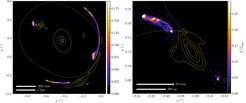Gravitational lensing reveals the detailed shape of a galaxy
Einstein’s General Theory of Relativity predicts that large concentrations of mass – such as galaxies – will bend light rays passing nearby, a phenomenon known as gravitational lensing. When a distant galaxy (the lens) lies exactly between us and an even more distant object (the source), the source is distorted and magnified into several images around the lens galaxy. A group at MPA and other institutes used very long baseline radio interferometry (VLBI) to study a gravitational lens system in high resolution. This reveals extreme detail in the lensed images, and provides a new window into the physics of lens galaxies.
The precise shape and magnification of the images in a gravitational lens system allows us to learn about the way mass is distributed in the galaxy that is acting as a gravitational lens, which reveals information about the formation and evolution of the galaxy. For instance, gravitational lensing can show whether the center of a lens galaxy is puffy or concentrated, which tells us about the heating and galactic winds blown by supernovae and active galactic nuclei (AGN, supermassive black holes that launch outflows at relativistic speeds). Gravitational lensing can also reveal the presence of low-mass dark matter haloes, which are detectable only through their gravitational effect. This lets us study the nature of dark matter itself.
The success of gravitational lens observations in revealing these physics depends on the smallest level of detail that can be detected, i.e. the angular resolution of the observation. So far, most existing gravitational lens systems have been observed with the Hubble Space Telescope (~120 milli-arcsecond resolution). Some have been followed up using the W.M. Keck adaptive optics system (~70 mas), and still fewer with the Atacama Large Millimeter Array (ALMA; ~25 mas). These observations are sufficient to constrain some very simple mass models, or to detect dark matter sub-haloes as small as 100 million solar masses. Pushing the field of gravitational lens modeling into the milli-arcsecond regime drastically increases the amount of astrophysical information we can extract from gravitational lens observations; at present, very long baseline interferometry (VLBI) is the only observational tool that can resolve details smaller than 5 milli-arcseconds.

In this work, we present the first analysis of a gravitational lens system observed at <5 milli-arcsecond resolution using VLBI, in which both a detailed model for the mass of the lens galaxy and an image of the source are reconstructed. The analysis used an advanced pipeline for VLBI data developed by our group at MPA. This observation of the lensed radio jet MG J0751+2716 exhibits extremely long, thin lensed arcs covering a wide range of positions around the lens galaxy, which are perfect for revealing the underlying gravitational landscape. In the figure, one can clearly see the jet structure of the reconstructed source, with bright knots of radio emission stretching away from the host galaxy.
We needed to include significant complexity in the mass model of the lens galaxy in order to clearly reconstruct the source. We found that the mass in this lens is highly concentrated towards the center, indicating that supernova and AGN feedback are relatively weak in this galaxy, a result which has been found in other gravitational lens galaxies as well. We also had to include extra parameters (angular multipole perturbations) in order to account for the fact that the lens galaxy is not perfectly elliptical (as is often assumed in lens modeling), as well as parameters describing tidal forces due to nearby galaxies, which pull on and deform the lens galaxy.
Even though our model captures the mass distribution in the lens galaxy only on scales larger than 1-2 kiloparsecs, we found that it fits the data very well. For a high-resolution observation, which can resolve such fine details in the lensed arcs, this was quite unexpected. This intriguing result motivates our main goal to use gravitational lenses observed with VLBI to search for low-mass dark matter haloes, whose presence or absence will help to constrain dark matter particle models. Our work demonstrates how VLBI observations can play a key role in the science of galaxy-scale strong gravitational lensing, as they can reveal structure in the gravitational landscape that is otherwise inaccessible with current optical telescopes.












